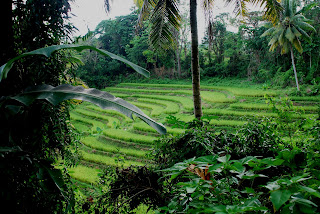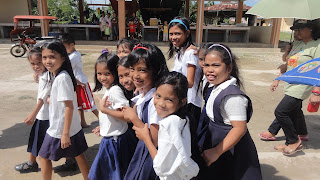Wednesday night we got word that there had been a possible sighting of a blue near Pamilacan, so we headed out on Thursday morning to check it out. Blue whales are rare around the world (listed as endangered by the IUCN red list- the global listing for wildlife species), but are particularly rare in the Philippines. There has only been 4 confirmed sightings EVER, with the earliest only being in 2004. Now of course, it doesn't mean that blues didn't exist here before last decade, but there hasn't been a whole ton of cetacean research done in this area, and therefore, little is known about what could have/should have/would have been here prior to massive global whaling that targeted species like blues.
The survey started out by finding our friend the Bryde's whale- the same animal we had spotted in the area last week. We hung out with it for a bit to collect some more information on it's diving pattern and take a few ID shots to confirm it was the same individual before heading off in search of something else. The waters seemed suprisingly quiet and just as our concentration was starting to waiver, one of the boat crew spotted a blow wwwaaaaayyyyy in the distance. It was a BIG blow and as we got closer we realize it was a BIG animal. (Please note that most of these pictures are cropped, but some of these pictures are closer than 100m, which is the guideline for approach not only in Canada, but the Philippines as well. We are under a research permit, and also had the engines off when the close photos were taken).
Blue with Pamilacan in the background (Physalus 2012)
This blue wasn't actually that large for a blue whale. We estimated about 20m (large individuals can break 30m), but it was still impressive. It is possible that the blues seen here in the Philippines are of the pygmy variety (like those found in Sri Lanka), or this could have just been a smaller/younger animal. The one feature that really struck me was the 'splash guard' around the blowholes- huge compared to something like a humpback.
Starting down a nose of the blue, who had just changed directions.
Splashguard in profile.
Remoras on the flank under the dorsal fin.
Surreally, as if the sighting could get any better, it did! A group of spinner dolphins all of a sudden mobbed the whale (why dolphins do this to large whales is unclear, my theory is that they are just jerks). The whale took off with the dolphins in hot pursuit. Imagine the scene, a blue whale booking it as fast as it could and a group of about 100 spinners flying through the air at their top speed to keep up! Our little banca boat couldn't match the pace, they were moving so quickly!
Blue with spinners close behind
Spinners in pursuit!
The dolphins eventually moved off and the whale slowed down, but unfortunately, we had to end our encounter. Leaving the scene, it all still felt a bit unreal- I'd just seen a blue whale. They do exists, Rob... ;)
PS. This was my "I just saw a blue whale" face.
























































